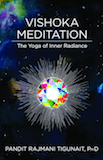The traditional system of meditation places equal emphasis on the technique-driven component of meditation and on the set of practices that allow us to recognize and conquer the mental tendencies that hinder our quest. When put into practice in a well-structured, time-bound way, this twofold dimension of meditation is technically known as purashcharana. Because of its inherent design, this well-structured, time-bound meditation forces us to transcend our limitations and take a step (charana) forward (purash), and continue moving forward until the practice is complete.
We often do our daily meditation by rote. We take our seat, do some preparatory practices, and begin meditating. During our meditation, random thoughts continually appear and disappear. As long as these random thoughts do not completely block the flow of meditation, we tell ourselves we are meditating. Because the time we allot for meditation is quite short and filled with preparatory and ancillary practices, we do not reach a place where our meditation is hijacked by strong thought currents. This fills us with the pseudo-satisfaction of completing our daily 30-minute meditation. But this type of daily meditation fails to show us the true nature of our mind and its hidden contents. It has a calming effect on our body and nervous system, but contributes little to our self-realization. Only when we commit ourselves to doing a purashcharana, a well-structured, time-bound practice with built-in contemplative tools, do we get a chance to see, confront, and conquer the hidden contents of our mind. This allows meditation to bear optimal fruit.
Seeing, confronting, and conquering the hidden contents of our mind allows meditation to bear optimal fruit.
The following experience shared with me by my teacher, Swami Rama, is an example of doing a purashcharana. This story will help us see how cleverly negative tendencies emerge, how they dull our power of discernment, how they motivate us to act against ourselves, and ultimately, how we can free ourselves from such tendencies once and for all.
Swami Rama, whom I always refer to as Swamiji, took monastic vows in late adolescence and attended college as a monk. Monastic rules demanded that he keep his interactions with others to a minimum. He was not supposed to interact with women, especially not with single women his own age. The more he complied with monastic rules the more attention he drew. Fearing he might violate his vows, he developed a way of keeping some distance from others while living among them. He avoided embracing his friends, shaking hands, and making eye contact with women. This left him with only a few friends, and even with them he had little in common. When college was in session, he was occupied with his studies, and during summer vacations, he returned to his master in the Himalayas.
His master was a great adept with more than half a century of direct experience. He did not want his student to grow up as a hedgehog, which curls up into a ball when threatened. He made sure Swamiji would discover and confront the hidden tendencies of his mind and conquer them before they could create havoc, particularly in his meditation. To this end, he instructed Swamiji to undertake a 40-day meditation practice while following the rules of purashcharana. The place his master chose for the practice was near a cremation ground outside Darjeeling, in the eastern Himalayas.

The practice Swamiji undertook there was not new in itself. He had been doing this practice for several years. What was new were the set of dos and don’ts and the contemplative disciplines accompanying the practice. As per his master’s instructions, Swamiji lived in a small hut at the edge of a cremation ground. He cooked his meals and washed his clothes. With the exception of occasional trips to town to fetch groceries and firewood, he spent all his time in the immediate vicinity of the cremation ground.
As part of his practice, Swamiji woke up at dawn, bathed in the nearby stream, and sat for meditation. That took barely three hours. Cooking, eating, and doing dishes took another two hours. He was instructed to spend the rest of the time doing things we normally don’t associate with meditation.
From sunrise to sunset Swamiji observed silence, which included refraining from reading and writing. The practice demanded that he go for a walk every afternoon. While walking he was instructed to pay attention to the beauty and grandeur of the mountains, discover his connection with them, and reflect on the purpose of their existence: Who are their parents? Who are their friends? What makes them so stable? What is their purpose? Why does each peak stand alone? How do they relate to the valleys? How do they feel when they are covered with snow and how do they feel when the snow melts away?
What is the secret of their happiness?
Swamiji was further instructed to sit on the stream bank and watch the constant flow of water, its dance with rocks and pebbles: What is its source? Does it know where it is going? Look at the flowers: What is the secret of their happiness? Are they aware they will soon drop their petals and become part of the dust? Do they care about the future that awaits them?
At night he was to contemplate the infinitely vast congregation of stars: Who is their creator? What sustains their existence? What are they trying to achieve by shining there? What is their contribution to the universe? Do these celestial bodies go through old age, disease, and death just as we do?
He was also instructed to watch what was going on at the cremation ground: How long has it been there? How many bodies has it consumed? Will its hunger ever be satisfied? Is anyone beyond its reach? What can I learn from the flames of the funeral pyres, which consume bodies so fearlessly?
His master instructed Swamiji to eat his meals only after offering them to divine providence. He told him to maintain the awareness that the food he ate during the 40 days of the practice was meant for propitiating consciousness, which in her own mysterious way provides nourishment to the body and mind. When going to bed, he must offer his gratitude to Ratri Devi, the goddess of night, who skillfully takes our worries away, thus granting us sleep. Upon awakening, he must remember chiti shakti, the power of consciousness, which motivates our mind and heart to start our day and attend our dharma.
You understand the value of these simple-seeming practices only when you are in trouble.
In concluding his instructions, his master said, “Never underestimate the power of simplicity. See how simple breathing is. You inhale and exhale. Such a simple phenomenon keeps you alive. When something goes wrong in your breath and you struggle to breathe, you realize its importance. The same is true with meditation. You understand the value of these simple-seeming practices only when you are in trouble.”
Swamiji began his practice exactly the way his master had instructed. For the first few weeks, he enjoyed it immensely. Then he began missing his friends. He wanted to write to them and not having access to pen and paper made him restless. The more he remembered the instructions not to read or write, the more his restlessness grew. While taking his afternoon walk, he wanted to talk to the people working in the fields, but the practice demanded that he preserve his solitude and talk to the mountains instead. The more he craved human contact, the less he enjoyed the flowing streams, smiling flowers, and twinkling stars. He found no meaning in the funeral pyres. He still did his meditation, but the contemplative aspect of the practice declined drastically.
His master had told Swamiji that this 40-day practice would give him a direct experience of an aspect of himself he had never known before. Swamiji interpreted his master’s prediction to mean he would have knowledge of his past life or what was going to happen in the near future. Or perhaps it meant he would know how many lifetimes he had been on the spiritual path. Or he would know his relationship with the sages of the tradition and see how much knowledge he had already amassed. . . . And all that knowledge would again come forward as the result of the practice.

During the last few days of the practice, Swamiji started counting the hours he spent in meditation. During the contemplative periods of the practice, he began re-evaluating his interpretation of his master’s prediction and wondering if he was any closer to achieving what his master had promised.
On the 39th day, a train of thought began running through his mind during his afternoon walk: “How absurd it is that I’m talking to mountains. What is so spiritual about discovering my connection with them? Am I doing anything more than just killing time? My friends must be enjoying their summer vacation and here I am, practicing simplicity in the pursuit of discovering an aspect of myself previously unknown to me. If a 39-day practice has not yielded a result, why should I expect one more day to make any difference?”
Swamiji made a decision—he would stop his practice immediately, spend a few days in Darjeeling, and then return to Delhi. He picked up his belongings and walked toward the city. Passing through a street on the outskirts, he heard a song wafting from one of the houses. He found the chorus mesmerizing: “The night is long, but there is very little oil in the lamp. . . . Life is short, but the journey is long. . . .” The beat of the accompanying drum said dhik, dhik, “shame on you, shame on you.” Swamiji took it as a message, returned to his hut, and continued his practice.
On the 40th day, he had the experience his master had predicted. During the last few moments of the practice, his sense of identity as an individual evaporated. His consciousness expanded beyond the boundaries of his body and conscious mind. Mountains, streams, stars, sky, the cremation ground—all merged in him and he merged in them. His expanded consciousness was neither small nor big, neither deep nor shallow. It contained neither past nor future, virtue nor vice. It was neither celestial nor earthly. It was free from any trace of bondage or freedom. It was an awareness that expressed the feeling of existence and non-existence simultaneously. This experience lasted a second or an eon—impossible to say, for it was outside the realm of time. The experience revealed an immutable truth: I am a child of immortality. So is everyone.
Source: Vishoka Meditation by Pandit Rajmani Tigunait, PhD

